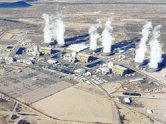Where Does Electricity Come From?
Most electricity is generated. Which means a piece of equipment called a generator is utilized to generate electricity. A generator is a device that converts mechanical energy into electrical energy. A generator has windings made of wire, which must spin inside of a set of magnets. As the windings pass through the magnetic fields of the magnets electrical energy is generated.
So, where does the mechanical energy come from to spin the windings in the generator?

Most power plants have turbines connected to generators. Water is super heated into steam, which is then directed at the blades in the turbine forcing them to spin. In order to heat the water there are a number of fuels that are used. Most common in the United States are fossil fuels such as coal, natural gas and oil, with coal responsible for producing approximately
47% of all electricity produced in this country. Nuclear power is also used in the same fashion to heat water into steam to turn turbines. Unlike the fossil fuels, nuclear power generation produces no pollution. Nuclear power generation is the cleanest, least expensive way to generate electricity using steam turbine technology. Pictured above is the Palo Verde Nuclear Generation Station in Arizona.
Another method of generating electricity is hydroelectric generation. This method uses the force of falling water to turn turbine blades. This can be achieved by harnessing the power of a waterfall or by creating a dam on a river. A dam will back the river up creating a reservoir. Water is let into the top of a dam though intake towers and falls to the bottom of the dam where the turbines are located. This method is also a clean way to generate electricity. The draw back is you need a moving body of water (not always available).
Pictured to the right is the Hoover Dam on the Arizona/Nevada border. This hydroelectric dam backs-up the Colorado River and provides electricity to Arizona, California, and Nevada.

Wind turbines work in a similar manor. As the wind blows it turns the fan blades, which in turn spins the generator windings. Although a very clean method of generating electricity, wind generation of electrical power can only provide a small fraction of what we consume.
Solar electricity unlike turbine produced electricity has no moving parts. Therefore no mechanical energy is required. A photovoltaic (PV) array (or solar panel) collects sunlight and the wafers of semi-conductor material inside the PV array use light (photons) to generate electricity. The PV arrays generate DC electricity and must be converted to AC electricity to be used for household consumption. To date solar electrical systems are rather expensive to be a viable replacement for fossil or nuclear options when demand is considered.